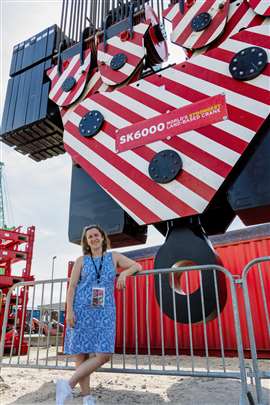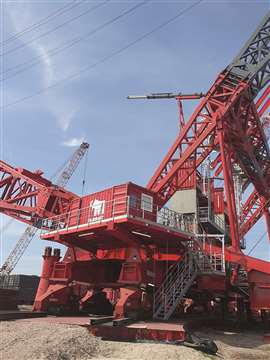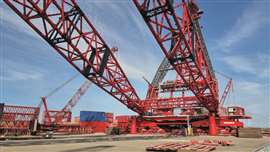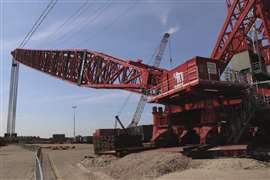On site: Mammoet’s 6,000 tonne ring crane
11 September 2024
Specialist heavy lift giant Mammoet has launched its SK6000 which it claims as the world’s strongest land-based crane. Niamh Marriott went to see it.
Visible from well over 10 kilometres away from the Westdorpe site in the Netherlands due to its impressive size, the 6,000 tonne capacity super heavy lift SK6000 ring crane has now been fully assembled for testing.
 The back mast of the new SK6000 uses main boom sections from this giant’s smaller sibling, the 5,000 tonne capacity SK350.
The back mast of the new SK6000 uses main boom sections from this giant’s smaller sibling, the 5,000 tonne capacity SK350.
Mammoet used its own cranes for the assembly, which began in June 2024, including a 250 tonne capacity crawler crane and a 140 tonne Gottwald mobile harbour crane.
Crane development
The new model’s design follows on from the existing SK190 and SK350 models which came as part of Mammoet’s acquisition of ALE. Its enormous capability means larger modules can be installed, meaning shorter build time with less onsite construction which means better quality and safer operations.
 Crane and Transport Briefing’s Niamh Marriott on site with the SK6000.
Crane and Transport Briefing’s Niamh Marriott on site with the SK6000.
The SK6000 can lift 3,000 tonnes to a height of 220 metres and will allow the use of new construction techniques for offshore wind projects and onshore new build projects like nuclear plants. The company said it can be used in a range of different industries and applications. Its fully battery powered options offer green opportunities for eco-conscious sites but can also be powered using traditional diesel engines.
Maximum capacity is achieved with 4,200 tonnes of ballast and the crane can be transported using 300 shipping containers to any location in the world.
The crane is undergoing testing at Westdorpe, ready for deployment on its first project later in the year. The company said it will be transported to a client’s site in Asia.
Gavin Kerr, Mammoet director of global services, said, “This crane is truly a world record feat of engineering, with a production schedule to match.
Sustainability
“The basis of the starting point was to build a 6,000 tonne crane,” he explained. “We wanted that to be a solution, not for tomorrow or even one year. We really wanted to ensure that it would be relatively future proof, flexible and scalable. Sustainability was at the heart of the design – reusing existing components as much as we possibly could and to have forward and backwards compatibility with the existing SK family of systems.
“The back mast is actually the main mast of the SK 350. The main mast is this new construction, which can also be used as a gantry system. So it has dual purpose capabilities.
 Some components in the new SK6000 are shared with other cranes in the SK series.
Some components in the new SK6000 are shared with other cranes in the SK series.
“We wanted to ensure that we would be fully electric, that we would have the capability of operating the crane on electric power. And together with our electric SPMTs, we imagine the future of where we can give a full carbon free solution.”
Training operators
“We had to do additional training for the operators”, says Erik Visser, senior lead engineer for the SK6000. Visser worked on the crane from its inception.
 Assembled and ready for testing at Mammoet’s yard in Westdorpe, Netherlands.
Assembled and ready for testing at Mammoet’s yard in Westdorpe, Netherlands.
“We are training them here on-site. As we were setting up the system, we are directly training the operators. The set up is in line with the previous SK series. It’s more like a continuation of the range. Some of the screens and buttons and functions are still the same as were in the smaller cranes so that helps a lot with training. Once we complete the module in the control system, the operators will be trained to work with that.
It’s not the design engineer who pulls up the main parts, it’s actually the operators. “When it leaves this test yard, they are capable of breaking down the machine too. The full training takes a couple of weeks. It will be a dedicated crew who stay with the crane the whole time. Training was going on at the same time as building the crane and setting it up for testing. The team have been here for a few months, getting all the details from assembly up to operation and control.”
 The SK6000 is “a world record feat of engineering,” said Gavin Kerr at Mammoet.
The SK6000 is “a world record feat of engineering,” said Gavin Kerr at Mammoet.
CONTÁCTESE CON EL EQUIPO





